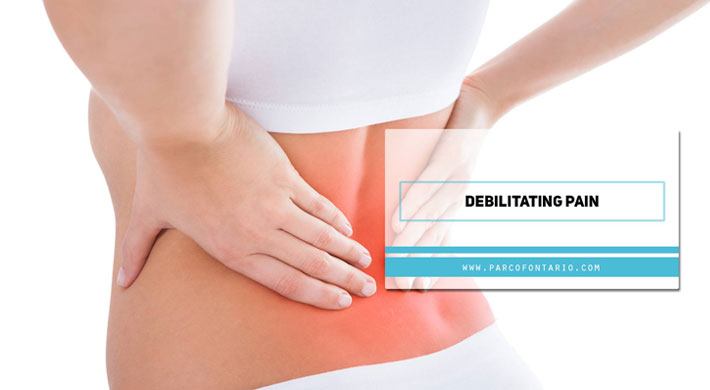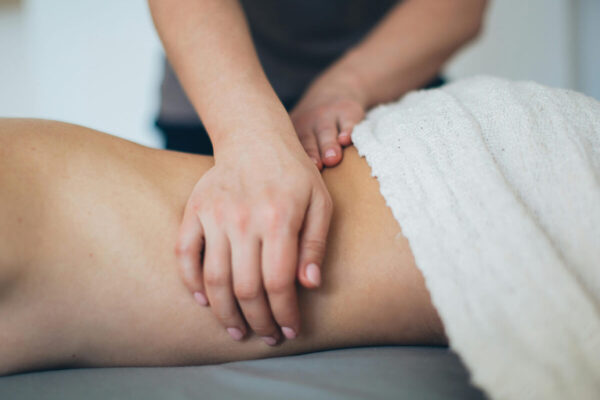What’s the Cause of My Back Pain?

Back pain can be chronic and affect your ability to be active, making it challenging for you to get through the day. It can have a significant impact on quality of life. Chronic back pain does not simply affect a person physically — it can also cause emotional turmoil, dependence on medication, difficulties at work, and social isolation.
Importance of a Healthy Spine
A healthy spine is fundamental to a happy and healthy lifestyle. The spine is made up of 24 vertebrae, separated by discs. As we move, these discs act as shock absorbers, allowing the spine to move in different, dynamic directions. The spine serves several important functions, including:
- Support – The spine holds a body upright and evenly distributes the weight of our torso, pelvis, hips, and legs.
- Movement – A healthy [LF1] spine makes movement possible. Stiffness and pain can trigger anxiety when our ability to move is reduced or limited.
- Stability – The strong postural muscles are responsible for providing a body the needed strength and balance to throw a ball or stand on one leg.
- Neurological Integrity – The spine, which serves as a protected channel for the spinal cord and nerve roots, sends neurological signals from the brain to the body.
When your spine is healthy, blood circulation improves, and nerves get a sufficient supply of oxygen and nutrients. Engaging in regular exercise and stretching is crucial in maintaining spinal flexibility. However, avoid excessive strain on the back because it can result in pain and stiffness.
Chronic Back Pain Causes
Unfortunately, not many of us pay attention to our spine’s health until we experience debilitating back pain. Chronic back pain reduces our ability to perform daily tasks. It is one of the leading causes of disability and time lost from work.
Here are some common causes that could be triggering your back pain:
- Sitting too Long – No matter how expensive and fancy your office chair is, sitting all day without breaks can be bad for your back. Prolonged sitting reduces blood circulation and increases pressure on the spinal discs. This increase is 30 percent greater than when standing or walking. Although you may be using lumbar support, it does not effectively reduce back pain, especially if it is not positioned properly at the base of the spine.
Solutions:
- Get up every hour to walk around the office or stretch at your desk.
- Keep your head straight while typing or reading.
- Do not slouch while sitting.
- Tilt your chair back slightly to alleviate the load on your back and position your feet firmly on the floor.
- Poor Diet – Unhealthy dietary choices (e.g. food with high-fat content, sugar, calories, and salt) contribute to weight gain. Being overweight or obese places more pressure on the back. A Stanford University study showed that extremely overweight people are four times more likely to experience lower back pain. Additionally, processed sugar can trigger inflammation and back pain.
Solutions:
- Perform 20 minutes of daily exercise to reduce the risk of back pain by 32 percent.
- Cut back on sugary foods (e.g. doughnuts, cake, cookies, candies)
- Wrong Shoes – High-heeled shoes alter the normal angle of the body. This creates an uneven distribution of weight over the spine and triggers improper spine alignment, putting more stress on the knees, hips, and back. This instability leads to injury and pain that radiates from the knees to the back.
Wearing flip-flops and backless flats can also create instability because they allow your heels to slide, also contributing to uneven distribution of weight. Worn out shoes also cause back pain because they do not have proper arch support.
Solution:
- Buy a new pair of shoes with proper arch support or replace old inserts with new ones.
- Wear low-heeled, comfortable shoes instead of high heels.
- Breast Size – Large-breasted women carry more weight in front than small-breasted women. Although a bra provides support, wearing the wrong bra size can cause shoulder, neck, and back pain, and/or a pinched nerve in the neck. A poorly-fitting bra does not provide proper support and creates posture problems, leading to back pain and tension.
Solutions:
- Seek assistance when purchasing a supportive bra; wear the right bra size to minimize hunching and relieve back pain.
- Wear a racerback bra to pull shoulders back.
- Emotional and Mental Strain – Psychological and emotional factors can contribute to chronic back pain. Anxiety can eventually trigger the stress response of the body, causing it to become more resilient or tense. The body also releases a cascade of chemicals that cause muscle spasms and tension. The consequent shoulder, neck, and back pain can render you unable to move. When the body remains in a state of elevated stress, it causes the group of muscles supporting the spine to become tense, resulting in limited mobility and flexibility. Additionally, stress can potentially change our behaviour and posture, including the way we sit, sleep, and move.
Solutions:
- Stretch to loosen tight muscles.
- Be mindful of your posture, especially when sitting.
- Take yoga and pilates classes to increase body awareness, improve breathing techniques, and strengthen core muscles.
- Apply a cold compress to relieve inflammation and reduce swelling and a hot compress to reduce muscle cramping and spasms.
- Smartphones and Tablets – Spending too much time hovering over your smartphone or tablet is bad for the neck and back. This creates a strain on neck muscles, leading to pain that extends throughout the spine and lower back. Also, talking on your cell phone can apply uneven pressure to your neck, especially if you are using a shoulder to balance the phone at your ear. The pain in your neck can radiate throughout the body. Too much texting can also cause neck strain when you’re repeatedly looking down at the screen.
Solutions:
- Use an earphone when talking on your phone for an extended period of time.
- Cut down on texting or take frequent breaks.
- When texting, hold your phone in front of you to prevent straining your neck.
Although exercise, stretching, and bed rest help alleviate back pain, your healthcare provider can recommend various treatments, including:
- Chiropractic Treatment – Spinal adjustment can effectively provide long-term back pain relief. It realigns the backbone, which helps reduce the strain and pain building in soft tissues among the back muscles.
- Acupuncture – Acupuncture is another effective tool in treating back pain because it improves the flow of energy in your body and corrects the imbalance of qi.
- Massage Therapy – Research published in the Pain Medicine journal suggests that various types of massage provide lasting relief from chronic lower back pain. Benefits include improved blood circulation, relaxation, and the reduction of inflammation.
A licensed physiotherapist, chiropractor, acupuncturist, and/or massage therapist can all be involved in your rehabilitative plan for pain reduction. Say goodbye to back pain by calling a reputable clinic today.
For professional physiotherapy and massage therapy services in Oshawa, call Physiotherapy and Rehabilitation Centres of Ontario at (905) 579-9938 to book an appointment. Our caregivers will guide you through the entire rehabilitation process. We use the latest treatments to effectively help our patients on their journey to recovery.




